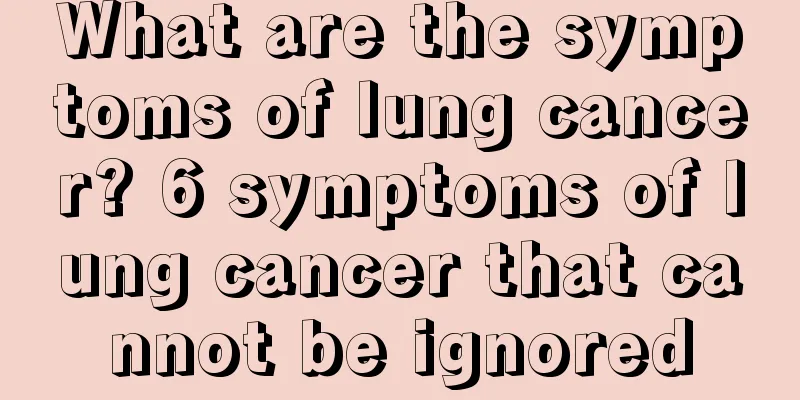What are the symptoms of lung cancer? 6 symptoms of lung cancer that cannot be ignored

|
In this world, cancer is a terminal illness, including lung cancer. If it is an early stage cancer, the patient still has a chance to be cured. Once the disease reaches the late stage, the patient cannot be cured. Therefore, everyone must understand the symptoms of lung cancer in life. So, what are the symptoms of lung cancer? Experts will give you a detailed introduction. Clinical manifestations: The clinical manifestations of lung cancer are closely related to the location, size, compression and invasion of adjacent organs, and metastasis of the tumor. Tumors grow in larger bronchi, often causing irritating coughs. Tumor enlargement affects bronchial drainage, and secondary lung infection may cause purulent sputum. Another common symptom is bloody sputum, usually with blood spots, blood streaks, or intermittent hemoptysis. Even if some patients have bloody sputum once or twice, it is also of great reference value for diagnosis. Some patients may experience chest tightness, shortness of breath, fever, and chest pain due to large bronchial obstruction caused by tumors. When advanced lung cancer compresses adjacent organs or tissues or metastasizes to distant sites, it may cause: ①Compression or invasion of the phrenic nerve, causing ipsilateral diaphragmatic paralysis ②Compression or invasion of the recurrent laryngeal nerve, causing vocal cord paralysis and hoarseness ③ Compression of the superior vena cava causes venous distension in the face, neck, upper limbs, and upper chest, subcutaneous tissue edema, and increased venous pressure in the upper limbs ④ Invasion of the pleura, which can cause pleural effusion, mostly bloody ⑤ Cancer invades the mediastinum and compresses the esophagus, which can cause dysphagia ⑥ Upper lobe lung cancer, also known as pancoast tumor or superior pulmonary sulcus tumor, can invade and compress organs or tissues located at the upper opening of the thorax, such as the first rib, supraclavicular artery and vein, brachial plexus, cervical sympathetic nerves, etc., causing chest pain, distension of the jugular vein or upper limb veins, edema, arm pain and upper limb movement disorders, ptosis of the upper eyelid on the same side, miosis, enophthalmos, anhidrosis on the face and other cervical sympathetic nerve syndromes. In a small number of lung cancers, due to the production of endocrine substances by the tumor, non-metastatic systemic symptoms may appear clinically, such as osteoarticular syndrome (clubbing of the finger joints, periosteal hyperplasia, etc.), Cushing's syndrome, myasthenia gravis, male breast enlargement, multiple muscular neuralgia and other extrapulmonary symptoms. These symptoms may disappear after the removal of the lung cancer. The above content introduces the symptoms of lung cancer. For these symptoms, everyone should still master them carefully. In the future, once you find such symptoms, you should go to a large hospital for examination in time to avoid worsening of the disease. Once diagnosed, patients should follow the doctor's arrangements and never act on their own. I wish you good health! |
<<: What is the most common cause of lung cancer? Five high-risk factors for lung cancer
Recommend
Lemon and white vinegar to remove freckles
The combination of lemon and white vinegar has th...
What are the daily health care and nursing methods for the three highs
At present, the number of people suffering from t...
What should I do if my nose bridge is swollen after being hit?
A swollen nose is a very common phenomenon in lif...
What to do if you have anal bloating
If a patient often feels a feeling of heaviness a...
What are the causes of rectal cancer
What are the causes of rectal cancer? The causes ...
Why does my nose become red and swollen and hurt when touched?
If your nose becomes red and swollen, and you are...
Can moxibustion treat aggravated postpartum disease?
If postpartum disease is not treated in time, it ...
What is keratin
There are various nutrients in the skin, which ar...
Treatment recommendations for advanced gastric cancer in the elderly
We all know that if we discover a disease in the ...
What are the precautions for heatstroke prevention in summer
Summer is the season when we need to pay the most...
What are the early symptoms of glioma
Early detection and treatment of gliomas have a g...
Chinese medicine can cure brain cancer headache
At present in our country, due to the continuous ...
How to dress to look slimmer for thick legs
Everyone wants to have a pair of long, straight a...
What are the symptoms of advanced lung cancer?
What are the symptoms of advanced lung cancer? I ...
Can babies use olive oil to wipe their faces?
Olive oil is a natural vegetable oil, so it has n...









